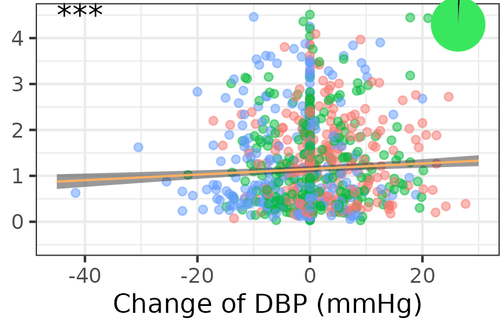Announcements
We are recruiting recommenders (editors) from all research fields!
Your feedback matters! If you have authored or reviewed a Registered Report at Peer Community in Registered Reports, then please take 5 minutes to leave anonymous feedback about your experience, and view community ratings.
Latest recommendations

| Id | Title | Authors | Abstract | Picture▼ | Thematic fields | Recommender | Reviewers | Submission date | |
|---|---|---|---|---|---|---|---|---|---|
21 Apr 2024
STAGE 1

Cross-cultural relationships between music, emotion, and visual imagery: A comparative study of Iran, Canada, and Japan [Stage 1 Registered Report]Shafagh Hadavi, Junji Kuroda, Taiki Shimozono, Juan David Leongómez, Patrick E. Savage https://psyarxiv.com/26yg5/Testing cross-cultural difference in the emotionality and visual associations of musicRecommended by D. Samuel Schwarzkopf based on reviews by Elena Karakashevska, Juan David Leongómez and Nadine Dijkstra based on reviews by Elena Karakashevska, Juan David Leongómez and Nadine Dijkstra
For many of us, music is far more than an auditory experience. It can trigger emotional reactions, evoke memories, and wide-ranging associations with other sensory modalities and cognitive states. Music also varies between different cultures in several ways. It remains unclear in how far the broader associations music has differs between cultural contexts, both in terms of the music itself and the listener. This study by Hadavi et al. (2024) seeks to better understand these relationships. Using an online survey targeted at 72 participants from anglophone Canada, Farsi-speaking Iran, and Japan (24 from each location), the researchers aim to address two straightforward hypotheses.
First, does faster tempo of music increase ratings of emotional arousal? Second, do participants match faster tempo music with denser visual line patterns? This latter measure aims to quantify the visual imagery evoked by the musical pieces. Imagery is a loaded term that is not used consistently across the cognitive neuroscience literature; one could argue that what the researchers are actually here is in fact mainly an association between tempo and a visual representation of tempo (or frequency). It certainly seems doubtful that persons listening to a piece of music will form a mental image of a bundle of horizontal lines. Yet, irrespective of how to interpret this experimental variable, it quantifies something about the impression listeners have when experiencing music, and whether these associations differ cross-culturally. The experiment has a balanced design, incorporating excerpts of musical pieces from each of the three cultural contexts, including both solo and group music. While the sample size is comparably low, given the online nature of data collection, it is based on a power analysis and relatively large expected effect sizes.
The proposed study was evaluated by three expert reviewers and the recommender over three rounds of in-depth review, plus a final round ironing out smaller issues. Reviewer Juan David Leongómez was recruited as a co-author after the first round of revisions. Following this process, the recommender decided that the manuscript met Stage 1 criteria and awarded in-principle acceptance (IPA).
URL to the preregistered Stage 1 protocol: https://osf.io/zdnkm
Level of bias control achieved: Level 6. No part of the data or evidence that will be used to answer the research question yet exists and no part will be generated until after IPA. List of eligible PCI RR-friendly journals:
References
1.Hadavi, S., Kuroda, J., Shimozono, T., Leongómez, J. D. & Savage, P. E. (2024). Cross-cultural relationships between music, emotion, and visual imagery: A comparative study of Iran, Canada, and Japan. In principle acceptance of Version 6 by Peer Community in Registered Reports. https://osf.io/zdnkm | Cross-cultural relationships between music, emotion, and visual imagery: A comparative study of Iran, Canada, and Japan [Stage 1 Registered Report] | Shafagh Hadavi, Junji Kuroda, Taiki Shimozono, Juan David Leongómez, Patrick E. Savage | <p>Many people experience emotions and visual imagery while listening to music. Previous research has identified cross-modal associations between musical and visual features as well as cross-cultural links between music and emotion and between mus... |  | Humanities, Social sciences | D. Samuel Schwarzkopf | 2023-03-01 02:48:54 | View | |
18 Jan 2023
STAGE 1

Beneath the label: Assessing video games’ compliance with ESRB and PEGI loot box warning label industry self-regulationLeon Y. Xiao https://osf.io/u7ghb?view_only=60cb55c3c3c74f76a8e170fb498e2789How effective is self-regulation in loot box labelling?Recommended by Chris Chambers based on reviews by Pete Etchells and Jim Sauer based on reviews by Pete Etchells and Jim Sauer
Paid loot boxes – items bought for real-world money that offer randomised rewards – are a prevalent feature of contemporary video games (Zendle et al., 2020). Because they employ random chance to provide rewards after spending real money, loot boxes have been considered a form of gambling, raising concerns about risk of harm to children and other vulnerable users. In response, some countries have taken legal steps to regulate and even ban the use of loot boxes, with only limited success so far (Xiao, 2022). At the same time, the Entertainment Software Rating Board (ESRB) and PEGI (Pan-European Game Information) now expect games that contain loot boxes to be marked with warning labels that, in theory, will enable users (including parents) to make more informed decisions. These requirements by ESRB/PEGI are not legally binding and may be considered a form of industry self-regulation.
In the current study, Xiao (2023) will investigate the effectiveness of self-regulation in the use of loot box labels. Study 1 examines the consistency of warning labels by the ESRB and PEGI, with the expectation that if self-regulation works as it should then these labels should always (or nearly always) co-occur. Study 2 establishes the compliance rate for labelling among popular games that are known to contain loot boxes, with a rate of ≥95% considered to be successful. The findings should prove useful in identifying the success or failure of self-regulation as a means of ensuring industry compliance with loot box labelling.
The Stage 1 manuscript was evaluated over two rounds of in-depth review. Based on detailed responses to the reviewers' comments, the recommender judged that the manuscript met the Stage 1 criteria and therefore awarded in-principle acceptance (IPA).
URL to the preregistered Stage 1 protocol: https://osf.io/e6qbm Level of bias control achieved: Level 3. At least some data/evidence that will be used to the answer the research question has been previously accessed by the authors (e.g. downloaded or otherwise received), but the authors certify that they have not yet observed ANY part of the data/evidence.
List of eligible PCI RR-friendly journals:
References
1. Zendle, D., Meyer, R., Cairns, P., Waters, S., & Ballou, N. (2020). The prevalence of loot boxes in mobile and desktop games. Addiction, 115(9), 1768-1772. https://doi.org/10.1111/add.14973
2. Xiao, L. Y. (2022). Breaking Ban: Belgium’s ineffective gambling law regulation of video game loot boxes. Stage 2 Registered Report, acceptance of Version 2 by Peer Community in Registered Reports. https://doi.org/10.31219/osf.io/hnd7w 3. Xiao, L. Y. (2023). Beneath the label: Assessing video games’ compliance with ESRB and PEGI loot box warning label industry self-regulation, in principle acceptance of Version 3 by Peer Community in Registered Reports. https://osf.io/e6qbm
| Beneath the label: Assessing video games’ compliance with ESRB and PEGI loot box warning label industry self-regulation | Leon Y. Xiao | <p>Loot boxes in video games are a form of in-game transactions with randomised elements. Concerns have been raised about loot boxes’ similarities with gambling and their potential harms (e.g., overspending). Recognising players’ and parents’ conc... |  | Humanities, Social sciences | Chris Chambers | 2022-09-17 00:14:51 | View | |
29 Jun 2022
STAGE 1

Go above and beyond: Does input variability affect children’s ability to learn spatial adpositions in a novel language?Eva Viviani1, Michael Ramscar2, Elizabeth Wonnacott1 [1: University of Oxford, 2: University of Tübingen] https://osf.io/2k6gj/Can discriminative learning theory explain productive generalisation in language?Recommended by Chris Chambers based on reviews by Julien Mayor, Natalia Kartushina, Caroline Rowland and 1 anonymous reviewer based on reviews by Julien Mayor, Natalia Kartushina, Caroline Rowland and 1 anonymous reviewer
One of the major challenges in studies of language learning is understanding productive generalisation – the ability to use words and linguistic structures in novel settings that the learner has never encountered previously. According to discriminative learning theory, this skill arises from an iterative process of prediction and error-correction that gradually reduces uncertainty, allowing learners to discriminate linguistic outcomes and to identify informative, invariant cues for generalisation to novel cases. In the current study, Viviani et al (2022) use computational modelling to propose a central hypothesis stemming from this theory that children will learn the meaning and use of spatial adpositions (words such as “above” and “below” that describe relative positions) more effectively when there is more variability in the use of the nouns within the spatial sentences. They will also test a range of additional hypotheses, including that learning and generalisation to novel contexts will be enhanced when children learn from skewed distributions that are similar to those found in natural languages.
The Stage 1 manuscript was evaluated over two rounds of in-depth review. Based on detailed responses to the reviewers' comments, the recommender judged that the manuscript met the Stage 1 criteria and therefore awarded in-principle acceptance (IPA).
URL to the preregistered Stage 1 protocol: https://osf.io/37dxr Level of bias control achieved: Level 6. Some of the data that will be used in the preregistered analyses was obtained in the second of two pilot experiments. However, since no further revisions to the analysis plan were made after this pilot, the risk of bias due to prior data observation remains zero, and the manuscript therefore qualifies for Level 6.
List of eligible PCI RR-friendly journals:
References
1. Viviani, E., Ramscar, M. & Wonnacott, E. (2022). Go above and beyond: Does input variability affect children’s ability to learn spatial adpositions in a novel language? In principle acceptance of Version 4 by Peer Community in Registered Reports. https://osf.io/37dxr
| Go above and beyond: Does input variability affect children’s ability to learn spatial adpositions in a novel language? | Eva Viviani1, Michael Ramscar2, Elizabeth Wonnacott1 [1: University of Oxford, 2: University of Tübingen] | <p>Human language is characterized by productivity, that is, the ability to use words and structures in novel contexts. How do learners acquire these productive systems? Under a <em>discriminative learning approach,</em> language learning involves... |  | Social sciences | Chris Chambers | 2021-11-15 15:04:42 | View | |
Is the past farther than the future? A registered replication and test of the time-expansion hypothesis based on the filling rate of durationQinjing Zhang, Yoshitaka Masuda, Kodai Toda, Kohei Ueda, Yuki Yamada https://doi.org/10.31234/osf.io/pb47nThe Temporal Doppler Effect may not be a robust and culturally universal phenomenonRecommended by Ljerka Ostojic based on reviews by Chris Chambers and 1 anonymous reviewer based on reviews by Chris Chambers and 1 anonymous reviewer
The Temporal Doppler Effect refers to the subjective perception that the past is further away than the future even when both temporal distances are objectively the same from the present moment (Caruso et al., 2013). In the current study, Zhang et al. ran a replication of this phenomenon and tested one possible explanation for it, namely that people overestimate the temporal distance of the past because the past is filled with more events than the future. This is because we can access information only about planned events for the future, but have access to both planned and unplanned events that happened in the past (filled-duration illusion; Thomas & Brown, 1974).
Over two studies, the authors found that the sampled participants reported feeling that the past was psychologically closer than the future, which is the opposite of what has previously been reported and termed the Temporal Doppler Effect (Caruso et al., 2013). In addition, the authors reported inconsistent results regarding the correlations between the psychological distance and different variables associated with the filling rate of duration. The authors discuss the differences between their own results and those by Caruso et al. (2013) in terms of methodological and contextual differences and highlight cultural aspects that may be critical to consider in future replications and overall testing of this phenomenon. As such, they highlight that, at the moment, the Temporal Doppler Effect should not be considered a robust and culturally universal phenomenon.
The Stage 2 manuscript was evaluated by two reviewers who had also reviewed the stage 1 report. Following a revision by the authors, which consisted of adding the Data Availability statement, as well as a more precise summary of the results in various sections of the report, the recommender judged that the manuscript met the Stage 2 criteria and awarded a positive recommendation.
URL to the preregistered Stage 1 protocol: https://osf.io/d9ec3/
Level of bias control achieved: Level 6. No part of the data or evidence that was used to answer the research question existed prior to Stage 1 in-principle acceptance. List of eligible PCI RR-friendly journals:
References
1. Caruso, E. M., Van Boven, L., Chin, M., & Ward, A. (2013). The temporal doppler effect: When the future feels closer than the past. Psychological Science, 24, 530-536. https://doi.org/10.1177/0956797612458804
2. Thomas, E. C., & Brown, I. (1974). Time perception and the filled-duration illusion. Perception & Psychophysics, 16, 449-458. https://doi.org/10.3758/BF03198571
3. Zhang, Q., Masuda, Y., Ueda, K.,Toda, K., & Yamada, Y. (2022). Is the past farther than the future? A registered replication and test of the time-expansion hypothesis based on the filling rate of duration. Stage 2 Registered Report, acceptance of Version 2 by Peer Community in Registered Reports. https://psyarxiv.com/pb47n/
| Is the past farther than the future? A registered replication and test of the time-expansion hypothesis based on the filling rate of duration | Qinjing Zhang, Yoshitaka Masuda, Kodai Toda, Kohei Ueda, Yuki Yamada | <p>People feel some events to be psychologically closer, while others to be farther away. Caruso et al. (2013) reported the Temporal Doppler Effect (TDE), in which people feel that the past is farther than the future, despite an equivalent objecti... |  | Social sciences | Ljerka Ostojic | 2022-08-20 09:59:09 | View | |
25 Mar 2024
STAGE 1

Assessing compliance with UK loot box industry self-regulation on the Apple App Store: a 6-month longitudinal study on the implementation processLeon Y. Xiao https://osf.io/7xft9Does self regulation by gaming companies for the use of loot boxes work?Recommended by Zoltan Dienes based on reviews by Chris Chambers, Lukas J. Gunschera and Andy Przybylski based on reviews by Chris Chambers, Lukas J. Gunschera and Andy Przybylski
Video games may provide the option of spending real money in exchange for probabilistically receiving game-relevant rewards; in effect, encouraging potentially young teenagers to gamble. The industry has subscribed to a set of regulatory principles to cover the use of such "loot boxes", including 1) that they will prevent loot box purchasing by under 18s unless parental consent is given; 2) that they will make it initially clear that the game contains loot boxes; and 3) that they will clearly disclose the probabilities of receiving different rewards.
Can the industry effectively self regulate? Xiao (2024) will evaluate this important question by investigating the 100 top selling games on the Apple App Store and estimating the percentage compliance to these three regulatory principles at two time points 6 months apart.
The Stage 1 manuscript was evaluated over one round of in-depth review. Based on detailed responses to the reviewers' comments, the recommender judged that the manuscript met the Stage 1 criteria and therefore awarded in-principle acceptance (IPA).
URL to the preregistered Stage 1 protocol: https://osf.io/3knyb
Level of bias control achieved: Level 2. At least some data/evidence that will be used to answer the research question has been accessed and partially observed by the authors, but the authors certify that they have not yet observed the key variables within the data that will be used to answer the research question. List of eligible PCI RR-friendly journals:
References 1. Xiao, L. (2024). Assessing compliance with UK loot box industry self-regulation on the Apple App Store: a 6-month longitudinal study on the implementation process. In principle acceptance of Version 3 by Peer Community in Registered Reports. https://osf.io/3knyb | Assessing compliance with UK loot box industry self-regulation on the Apple App Store: a 6-month longitudinal study on the implementation process | Leon Y. Xiao | <p>Loot boxes in video games can be purchased with real-world money in exchange for random rewards. Stakeholders are concerned about loot boxes’ similarities with gambling and their potential harms (e.g., overspending). The UK Government has decid... |  | Humanities, Social sciences | Zoltan Dienes | 2023-08-27 22:47:03 | View | |
17 Jan 2022
STAGE 1

Identifying Gaming Disorders by Ontology: A Nationally Representative Registered ReportVeli-Matti Karhulahti, Jukka Vahlo, Marcel Martončik, Matti Munukka, Raine Koskimaa, Mikaela von Bonsdorff https://osf.io/mpz9q/Do different screening instruments for ‘gaming disorder’ measure the same or different construct(s)?Recommended by Charlotte Pennington based on reviews by Daniel Dunleavy, Linda Kaye, David Ellis and 1 anonymous reviewer based on reviews by Daniel Dunleavy, Linda Kaye, David Ellis and 1 anonymous reviewer
There is considerable debate regarding the relationship between excessive gaming and mental health problems. Whilst the diagnostic classification of “gaming disorder” has now been included in the WHO’s International Classification of Diseases (ICD-11), the APA decided not to include this diagnosis in their Diagnostic and Statistical Manual of Mental Disorders (DSM-5) because the literature “suffers from a lack of a standard definition from which to derive prevalence data” (APA 2013, p. 796). Furthermore, screening instruments that aim to provide diagnostic classifications derive from different ontologies and it is not known whether they identify equivalent prevalence rates of ‘gaming disorder’ or even the same individuals. In this Stage 1 Registered Report, Karhulahti et al. (2022) aim to assess how screening instruments that derive from different ontologies differ in identifying associated problem groups. A nationally representative sample of 8000 Finnish individuals will complete four screening measures to assess the degree of overlap between identified prevalence (how many?), who they identify (what characteristics?) and the health of their identified groups (how healthy?). If these four ontologically diverse instruments operate similarly, this will support the notion of a single “gaming disorder” construct. If, however, the instruments operate differently, this will suggest that efforts should be directed toward assessing the clinical (ir)relevance of multiple constructs. This rigorous study will therefore have important implications for the conceptualisation and measurement of “gaming disorder”, contributing to the debate around the mixed findings of gaming-related health problems. Four expert reviewers with field expertise assessed the Stage 1 manuscript over three rounds of in-depth review. Based on detailed and informed responses to the reviewers' comments, the recommender decided that the manuscript met the Stage 1 criteria and therefore awarded in-principle acceptance (IPA). URL to the preregistered Stage 1 protocol: https://osf.io/usj5b Level of bias control achieved: Level 6. No part of the data or evidence that will be used to answer the research question yet exists and no part will be generated until after IPA. List of eligible PCI RR-friendly journals:
References
| Identifying Gaming Disorders by Ontology: A Nationally Representative Registered Report | Veli-Matti Karhulahti, Jukka Vahlo, Marcel Martončik, Matti Munukka, Raine Koskimaa, Mikaela von Bonsdorff | <p style="text-align: justify;">Gaming-related health problems have been researched since the 1980s with numerous different “ontologies” as reference systems, from self-assessed “game addiction” to “pathological gambling” (in the DSM-IV), “interne... |  | Medical Sciences, Social sciences | Charlotte Pennington | 2021-08-25 23:08:26 | View | |
17 Jan 2023
STAGE 1

Similarities and differences in a global sample of song and speech recordingsCorresponding authors: Yuto Ozaki and Patrick E. Savage (Keio University, Japan). Full list of 80 authors is in the manuscript https://psyarxiv.com/jr9x7Exploring cross-cultural variation in speech and songRecommended by Chris Chambers based on reviews by Bob Slevc, Nai Ding and 1 anonymous reviewer based on reviews by Bob Slevc, Nai Ding and 1 anonymous reviewer
For centuries, the ubiquity of language and music across human societies has prompted scholars to speculate about their cross-cultural origins as well as their shared and unique characteristics. Depending on the extent to which contemporary theories emphasise the role of biology vs. culture, a range of hypotheses have been proposed concerning expected similarities and differences in song and speech. One class of hypotheses stemming from cultural relativism assumes a lack of universal regularities in song and speech, and therefore predicts no systematic cross-cultural relationships. On the other hand, more recent evolutionary hypotheses such as the social bonding hypothesis, motor constraint hypothesis, and sexual selection hypothesis all predict differences or similarities in specific characteristic of vocalisations, such as pitch regularity, pitch interval size, and melodic contour. Existing results are mixed in their support of these predictions.
In the current study, Ozaki et al. (2022) embark on an ambitious project to elucidate cross-cultural similarities and differences between speech and song in 81 different linguistic varieties spanning 23 language families. Understanding precisely how song and speech are related is methodologically challenging due to the multitude of confounds that can arise in comparing natural recordings. Here the authors overcome these difficulties with four types of carefully controlled recordings: singing, recitation of sung lyrics, spoken description of the song, and instrumental version of the sung melody. The authors will then examine six features that are amenable to reliable comparison, including pitch height, temporal rate, pitch stability, timbral brightness, pitch interval size, and pitch declination. With this data in hand, the authors will ask which acoustic features differ reliably between song and speech across cultures, with the expectation that song will exhibit higher pitch, slower rate and more stable pitch than speech. At the same time, the authors expect song and speech to be reliably similar in the characteristics of timbral brightness, pitch intervals and pitch contours. In addition to these confirmatory tests, the authors will explore variation across a range of additional stimulus characteristics and ancillary research questions.
The Stage 1 manuscript was evaluated over two rounds of in-depth review. Based on detailed responses to the reviewers' comments, the recommender judged that the manuscript met the Stage 1 criteria and therefore awarded in-principle acceptance (IPA).
URL to the preregistered Stage 1 protocol: https://osf.io/jdhtz
Level of bias control achieved: Level 2. At least some data/evidence that will be used to answer the research question has been accessed and partially observed by the authors, but the authors certify that they have not yet observed the key variables within the data that will be used to answer the research question AND they have taken additional steps to maximise bias control and rigour.
List of eligible PCI RR-friendly journals: References
1. Ozaki, Y., Savage P. E. et al. (2022). Similarities and differences in a global sample of song and speech recordings, in principle acceptance of Version 2 by Peer Community in Registered Reports. https://osf.io/jdhtz
| Similarities and differences in a global sample of song and speech recordings | Corresponding authors: Yuto Ozaki and Patrick E. Savage (Keio University, Japan). Full list of 80 authors is in the manuscript | <p>What, if any, similarities and differences between song and speech are consistent across cultures? Both song and speech are found in all known human societies and are argued to share evolutionary roots and cognitive resources, yet no studies ha... |  | Social sciences | Chris Chambers | Bob Slevc, Nai Ding | 2022-09-16 16:03:10 | View |
27 Mar 2023
STAGE 1

Optimizing Esports Performance Using a Synergistic Mindsets InterventionMaciej Behnke, Daniël Lakens, Kate Petrova, Patrycja Chwiłkowska, Lukasz D. Kaczmarek, Jeremy P. Jamieson, James J. Gross https://osf.io/sp6avSynergistic Mindset Intervention for Competitive SituationsRecommended by Veli-Matti Karhulahti based on reviews by Lee Moore, Ivan Ropovik , Ivana Piterová and Jacob Keech based on reviews by Lee Moore, Ivan Ropovik , Ivana Piterová and Jacob Keech
Mindset theories suggest that the mere belief in the malleability of human abilities can already help one to develop related performance. On the other hand, one and the same performance situation can also be experienced in various affective ways, which differently contribute to performance outcomes. Arguably, appraising a performance situation as a “threat” instead of “challenge” is associated with maladaptive responses, such as impaired cardiovascular mobilization. If people could experience performance situations as positive challenges, this might also improve performance outcomes. Drawing from these connected theoretical premises, the synergistic mindset intervention was developed and tentatively found to help adolescents in stressful situations (Yeager et al., 2022).
In the present registered report, Behnke et al. (2023) build on the above and test whether the synergistic mindset intervention can help individuals in competitive gaming situations. The authors utilize one of the leading esport games, Counter-Strike: Global Offensive, and recruit its active players into randomized control and intervention groups for two weeks. Ultimately, the participants compete in a cash-prize tournament involving measures of affective experience and cardiovascular responses. Behnke et al. (2023) hypothesize that the synergistic mindset group will show greater challenge affective responses and superior performance outcomes. As such, the study design has significant potential to generate valuable evidence for various theoretical models and the synergistic mindset model in particular. The Stage 1 manuscript was evaluated over two rounds by four experts with experimental psychology specializations in mindsets, stress, and statistics. Based on the comprehensive responses to the reviewers' feedback, the recommender judged that the manuscript met the Stage 1 criteria and therefore awarded in-principle acceptance (IPA). URL to the preregistered Stage 1 protocol: https://osf.io/z3adb Level of bias control achieved: Level 6. No part of the data or evidence that will be used to answer the research question yet exists and no part will be generated until after IPA. List of eligible PCI RR-friendly journals:
References
Behnke M., Lakens D., Petrova K., Chwiłkowska P., Kaczmarek L. D., Jamieson J. P., & Gross J. J. (2023) Optimizing Esports Performance Using a Synergistic Mindsets Intervention. In principle acceptance of Version 3 by Peer Community in Registered Reports. https://osf.io/z3adb Yeager D.S., Bryan C.J., Gross J.J., Murray J., Krettek D., Santos P., ... & Jamieson J.P. (2022) A synergistic mindsets intervention protects adolescents from stress. Nature 607, 512–520. https://doi.org/10.1038/s41586-022-04907-7 | Optimizing Esports Performance Using a Synergistic Mindsets Intervention | Maciej Behnke, Daniël Lakens, Kate Petrova, Patrycja Chwiłkowska, Lukasz D. Kaczmarek, Jeremy P. Jamieson, James J. Gross | <p>Affective responses during stressful high-stakes situations can play an important role in shaping performance outcomes. For example, feeling shaky and nervous at a job interview can undermine performance, whereas feeling pumped and excited duri... |  | Social sciences | Veli-Matti Karhulahti | 2023-01-04 10:12:55 | View | |
Progression of white matter hyperintensities is related to blood pressure increases and global cognitive decline – a registered reportFrauke Beyer, Laurenz Lammer, Markus Loeffler, Steffi Riedel-Heller, Stéphanie Debette, Arno Villringer, A. Veronica Witte https://osf.io/k24pmWhite matter lessions are associated with increases in blood pressure and global cognitive declineRecommended by Chris Chambers based on reviews by Isabel Garcia Garcia based on reviews by Isabel Garcia Garcia
Cerebral small vessel disease (CSVD) is a common and multi-faceted set of pathologies that affect the small arteries, arterioles, venules and capillaries of the brain. The disease manifests through a range of symptoms and conditions, including psychiatric disorders, abnormal gait, and urinary incontinence, while accounting for 25% of strokes and nearly 50% of dementia.
The presence of CSVD is associated with white matter lesions detected as white matter hyperintensities (WMH) using neuroimaging, which have in turn been shown to predict future stroke, cognitive decline and dementia. While vascular risk factors of CSVD (such as hypertension and obesity) are also associated with CSVD, a complete picture of the predictive relationship between WMH, cognitive decline, and blood pressure remains to be determined, as does the role of sex/gender. These inter-relationships are important to determine for improving the diagnosis and treatment of CSVD.
In the current study, Beyer et al. analysed a large emerging dataset from the LIFE-Adult project – a longitudinal, two-wave, population-based study – to ask whether higher blood pressure predicts a greater increase in WMH, and whether progression of WMH is associated with measures of memory and executive function. In addition, the authors explored the relationship between abdominal obesity and WMH progression, and the extent to which WMH progression, and its interaction with vascular risk factors, depends on sex/gender.
Results revealed no reliable association between baseline blood pressure with WMH progression. WMH progression significantly predicted global cognitive decline but not decline in executive function specifically. Exploratory analyses revealed that increases in diastolic blood pressure as well as baseline and systolic blood pressure were associated with WMH progression, specifically in frontal periventricular regions, but there was no association of waist-to-hip ratio (a proxy of abdominal fat deposits) with WMH progression nor any gender-specific associations. The authors conclude that strict control of blood pressure might confer a protective effect, limiting WMH progression and negative effects on global cognitive function in the middle-aged to older population.
The Stage 2 manuscript was evaluated over one round of in-depth review. Based on responses to the reviewer's comments, the recommender judged that the manuscript met the Stage 2 criteria and awarded a positive recommendation.
URL to the preregistered Stage 1 protocol: https://osf.io/qkbgj Level of bias control achieved: Level 2. At least some data/evidence that was used to answer the research question had been accessed and partially observed by the authors prior to Stage 1 in-principle acceptance, but the authors certify that they had not yet observed the key variables within the data that were used to answer the research question.
List of eligible PCI RR-friendly journals: References
1. Beyer, F., Lammer, L., Loeffler, M., Riedel-Heller, S., Debette, S., Villringer, A. & Witte, A. V. (2023). Progression of white matter hyperintensities is related to blood pressure increases and global cognitive decline – a registered report [Stage 2]. Acceptance of Version 2 by Peer Community in Registered Reports. https://osf.io/k24pm
| Progression of white matter hyperintensities is related to blood pressure increases and global cognitive decline – a registered report | Frauke Beyer, Laurenz Lammer, Markus Loeffler, Steffi Riedel-Heller, Stéphanie Debette, Arno Villringer, A. Veronica Witte | <p>Introduction<br>White matter hyperintensities (WMH) reflect cerebral small vessel disease (cSVD), a major brain pathology contributing to cognitive decline and dementia. Vascular risk factors including higher diastolic blood pressure (DBP) have... |  | Humanities, Medical Sciences | Chris Chambers | 2024-02-15 17:16:37 | View | |
Phenomenological Strands for Gaming Disorder and Esports Play: A Qualitative Registered ReportVeli-Matti Karhulahti, Miia Siutila, Jukka Vahlo, Raine Koskimaa https://doi.org/10.31234/osf.io/q53jzThe lived experience of gamers: a comparative qualitative investigation of treatment-seekers and esports playersRecommended by Chris Chambers based on reviews by Malte Elson and Peter Branney based on reviews by Malte Elson and Peter Branney
Since 2018, the inclusion of “gaming disorder” in the ICD-11 has been met with a mixture of interest, confusion and controversy (Van Rooij et al, 2018), mirroring broader debates about the effects of gaming on mental health. One of the major gaps in understanding the validity of gaming disorder as an identifiable mental illness is the absence of qualitative studies comparing the lived experience of gamers who seek treatment with esports players who do not report health problems.
Here, Karhulahti et al. (2022) tackle this question in the first of two Stage 2 Registered Reports associated with their previous programmatic Stage 1 submission. Using interpretative phenomenological analysis in gamers and medical experts, they find that treatment-seekers and esports players differ in how gaming is associated with the sense of self, either interfering with the self for treatment-seekers or successfully integrating into the self for esports players. These findings help to identify the key characteristics of problematic and non-problematic gaming and call for more intensive and wide-reaching qualitative research in this area.
Following one round of in-depth review and revision, the recommender judged that the manuscript met the Stage 2 criteria and awarded a positive recommendation.
URL to the preregistered Stage 1 protocol: https://osf.io/a2rwg
Level of bias control achieved: Level 4. At least some of the data/evidence that was used to answer the research question existed prior to in-principle acceptance(IPA) but the authors certify that they did not access any part of that data/evidence prior to IPA.
List of eligible PCI RR-friendly journals:
References
1. van Rooij AJ, Ferguson CJ, Carras MC, Kardefelt-Winther D, Shi J, Aarseth E, Bean AM, Bergmark KH, Brus A, Coulson M, Deleuze J, Dullur P, Dunkels E, Edman J, Elson M, Etchells PJ, Fiskaali A, Granic I, Jansz J, Karlsen F, Kaye LK, Kirsh B, Lieberoth A, Markey P, Mills KL, Nielsen RKL, Orben A, Poulsen A, Prause N, Prax P, Quandt T, Schimmenti A, Starcevic V, Stutman G, Turner NE, Looy J van, Przybylski AK (2018) A weak scientific basis for gaming disorder: Let us err on the side of caution. Journal of Behavioral Addictions, 7, 1–9. https://doi.org/10.1556/2006.7.2018.19
2. Karhulahti V-M, Siutila M, Vahlo J, Koskimaa R (2022) Phenomenological Strands for Gaming Disorder and Esports Play: A Qualitative Registered Report. Stage 2 Registered Report, acceptance of Version 2 by Peer Community in Registered Reports. https://doi.org/10.31234/osf.io/q53jz
| Phenomenological Strands for Gaming Disorder and Esports Play: A Qualitative Registered Report | Veli-Matti Karhulahti, Miia Siutila, Jukka Vahlo, Raine Koskimaa | <p>The recent inclusion of gaming disorder in the ICD-11 as a mental disorder has further increased the importance of researching the health spectrum related to gaming. A critical area in this regard is the lack of clarity concerning the differenc... |  | Medical Sciences, Social sciences | Chris Chambers | 2022-06-11 23:49:03 | View |
MANAGING BOARD
Chris Chambers
Zoltan Dienes
Corina Logan
Benoit Pujol
Maanasa Raghavan
Emily S Sena
Yuki Yamada










